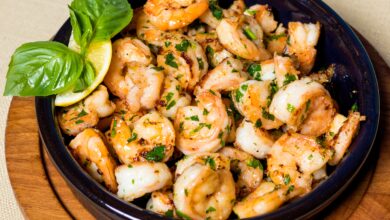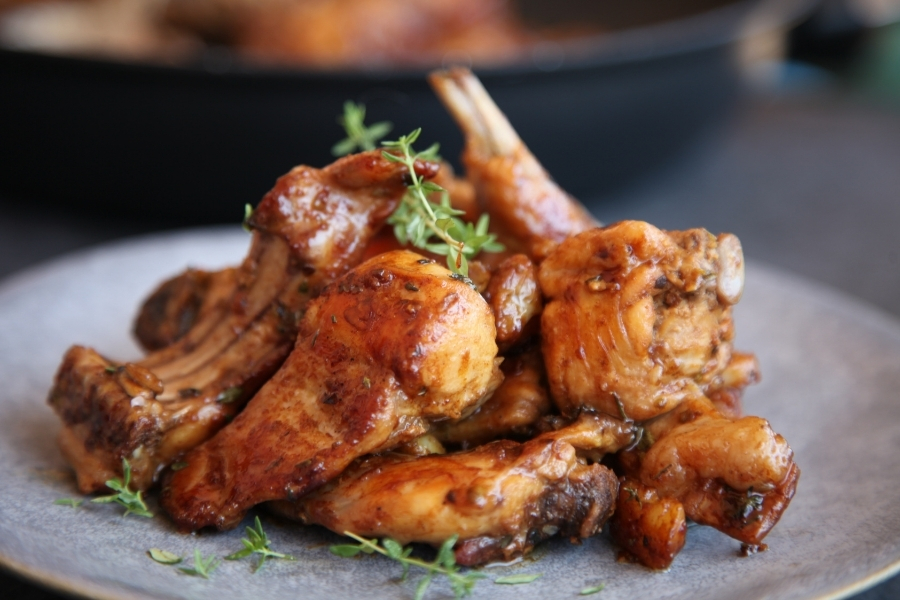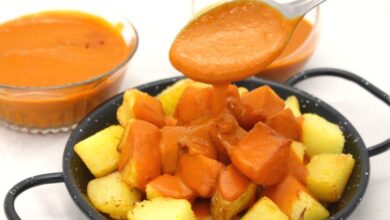Pisto Manchego (Spanish Ratatouille)
Today, in Spain from the Cuisine, we going to learn to elaborate one of the most famous Spanish vegan recipe, the Pisto Manchego recipe or “Spanish Ratatouille” in English.
Pisto Manchego is a dish that originated in the La Mancha region of Spain, and is a traditional recipe that has been prepared there for centuries. It is believed that the dish was invented by local farmers, who used the ingredients they grew in their gardens to create a tasty and comforting meal.
The dish is very similar to the French ratatouille, which is also a vegetable stew. The main difference between the two dishes is that the French ratatouille is usually made with eggplant and zucchini, while Pisto Manchego is made with peppers, tomatoes, onions, and garlic.
Pisto Manchego is usually served as a main course, although it can also be a side dish for other dishes. It can be eaten alone or with a slice of crusty bread to dip into the sauce.
In summary, Pisto Manchego is a traditional vegetable stew recipe originating from the La Mancha region in Spain, similar to the French ratatouille but with different ingredients. It is believed to have been invented by local farmers and has remained a popular dish in Spain for centuries.
Ingredients of Spanish Ratatouille
- 4 tablespoons of olive oil
- 1 large onion, chopped
- 2 garlic cloves, minced
- 2 green bell peppers, diced
- 2 red bell peppers, diced
- 2 medium-sized zucchini, diced
- 6 ripe tomatoes, peeled and chopped
- Salt and black pepper to taste
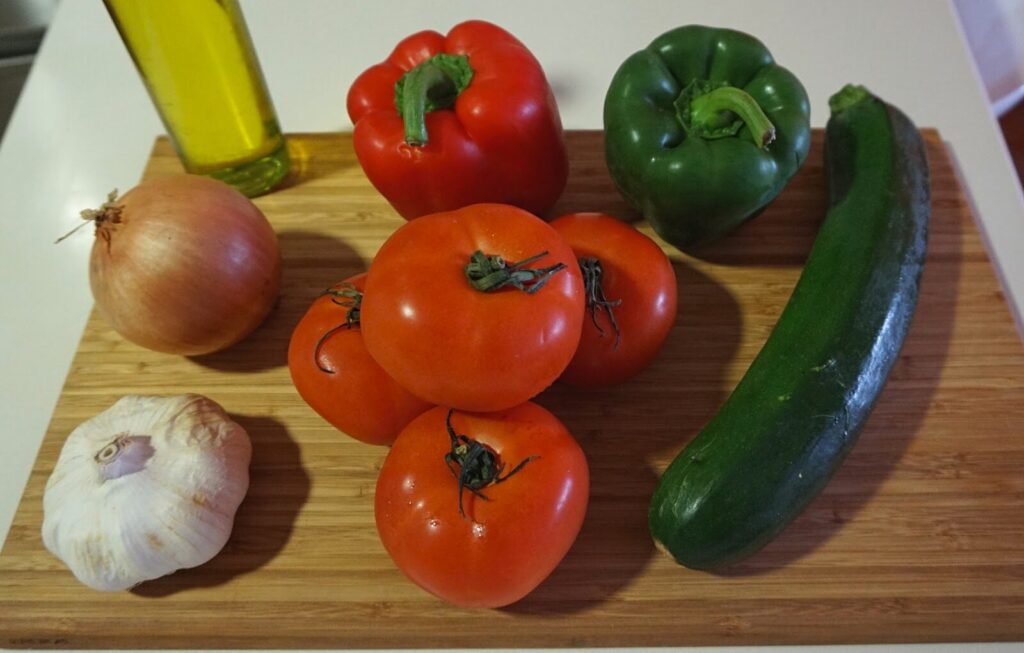
Ingredient substitutions for Pisto Manchego
Here are the notes and ingredient substitutions for Pisto Manchego:
- Olive oil: You can use any vegetable oil of your choice, such as canola or sunflower oil.
- Onion: You can use any type of onion you prefer, such as white, yellow, or red onion.
- Garlic: Fresh garlic is preferred, but you can use garlic powder as a substitute. 1 clove of garlic is roughly equivalent to 1/8 tsp of garlic powder.
- Green and red bell peppers: You can use any color bell peppers you prefer, or a combination of different colors.
- Zucchini: You can substitute with yellow squash, or any other summer squash of your choice.
- Tomatoes: Fresh tomatoes are preferred, but you can use canned tomatoes as a substitute. Use about 2 cans (14.5 oz each) of diced tomatoes in place of fresh tomatoes.
- Salt and black pepper: You can use any type of salt and pepper you prefer, such as sea salt or freshly ground black pepper.
With these ingredient substitutions, you can customize Pisto Manchego to your liking and create a dish that is perfect for your taste preferences.
Directions of Spanish Ratatouille recipe
Here are instructions for Pisto Manchego:
- Heat the olive oil in a large pot or Dutch oven over medium heat.
- Add the chopped onions and garlic and sauté until the onions are translucent and the garlic is fragrant, about 5 minutes.
- Add the diced green and red bell peppers and cook until they are soft, about 10 minutes.
- Add the diced zucchini and cook until it is tender, about 10 minutes.
- Add the chopped tomatoes and stir to combine.
- Reduce the heat to low and simmer the mixture for about 30 minutes, stirring occasionally.
- Season with salt and black pepper to taste.
- Serve hot as a main dish or as a side dish with crusty bread.
This recipe makes a delicious and hearty dish that is perfect for vegetarians or anyone who loves vegetables. The Pisto Manchego is a comforting and flavorful dish that is perfect for any occasion.
Tips for Spanish Ratatouille recipe
Here are some tips for making a delicious Pisto Manchgeo:
- Use fresh and ripe vegetables: Choose fresh and ripe vegetables for the best flavor. Look for firm and bright bell peppers and zucchini, and ripe and juicy tomatoes.
- Cut vegetables evenly: Cut the vegetables into even-sized pieces to ensure they cook evenly.
- Sweat the vegetables: Cook the onions, garlic, and peppers until they are softened and slightly caramelized. This will help bring out their sweetness and enhance the flavor of the dish.
- Simmer slowly: Allow the stew to simmer slowly over low heat for at least 30 minutes. This will allow the flavors to meld together and create a rich and delicious sauce.
- Adjust seasoning: Taste the dish and adjust the seasoning as needed. Add salt and black pepper to taste, and consider adding other spices or herbs like paprika, cumin, or thyme.
- Serve hot with crusty bread: Spanish Ratatouille is best served hot with a slice of crusty bread to dip into the sauce.
By following these tips, you can make a delicious and flavorful Pisto Manchego that will impress your family and friends.
Suggestions for serving Spanish Ratatouille
Here are some serving suggestions for Spanish Ratatouille:
- As a main dish: Spanish Ratatouille can be served as a main dish with a side of crusty bread or over a bed of rice or quinoa for a more filling meal.
- As a side dish: Spanish Ratatouille can be served as a side dish alongside grilled chicken, fish, or tofu for a healthy and flavorful meal.
- Topped with cheese: Top the dish with grated cheese, such as Parmesan or Manchego, for added flavor and texture.
- Garnished with fresh herbs: Sprinkle fresh herbs, such as parsley or cilantro, over the dish just before serving for a pop of color and added flavor.
- With a side salad: Serve Spanish Ratatouille with a side salad of mixed greens, tomatoes, and cucumbers dressed with a simple vinaigrette for a refreshing and healthy meal.
- As a dip: Spanish Ratatouille can also be served as a dip with pita bread or tortilla chips for a tasty and healthy appetizer.
- In some places in Spain, manchego ratatouille can be served with a fried egg on top. When eating it, it is recommended to stir the fried egg with the vegetables.
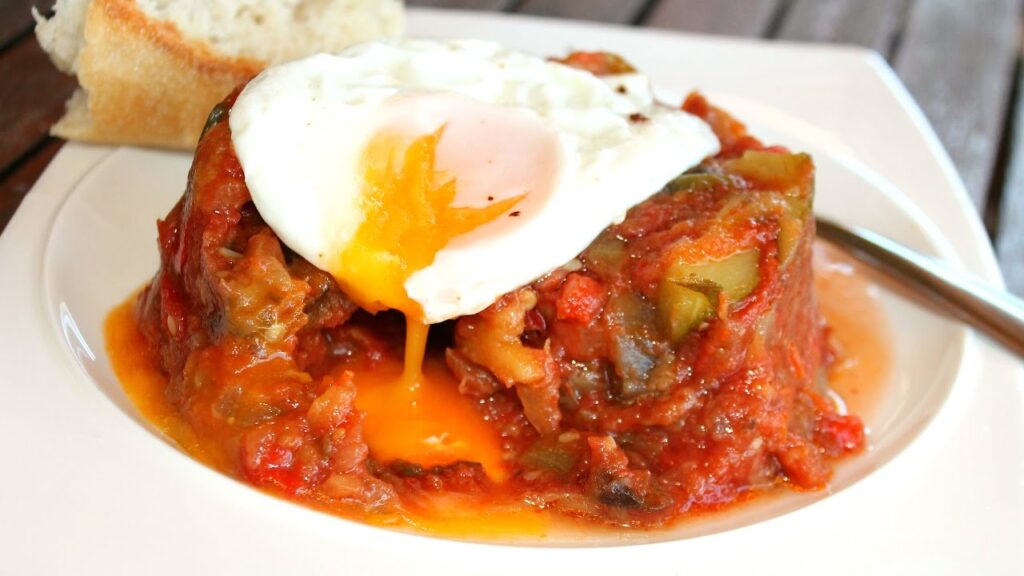
By trying these serving suggestions, you can enjoy Spanish Ratatouille in different ways and impress your guests with a versatile and delicious dish.
FAQs
Here are some possible frequently asked questions (FAQs) that people might have about making Spanish Ratatouille:
- Can I use different vegetables in Spanish Ratatouille? Yes, Spanish Ratatouille is a versatile dish that can be customized to your liking. You can use different vegetables like eggplant, mushrooms, or carrots, depending on your taste preferences.
- Is Spanish Ratatouille vegan or vegetarian? Yes, Spanish Ratatouille is a vegan and vegetarian dish since it is made with vegetables and does not contain any meat or animal products.
- How long does Spanish Ratatouille last in the fridge? Spanish Ratatouille can last up to 3-4 days in the fridge if stored in an airtight container.
- Can I freeze Spanish Ratatouille? Yes, Spanish Ratatouille can be frozen for up to 3 months. Store it in a freezer-safe container or freezer bag, and thaw it in the fridge before reheating.
- Can I make Spanish Ratatouille in advance? Yes, you can make Spanish Ratatouille in advance and reheat it when needed. It’s actually better the next day since the flavors have time to meld together.
- How do I serve Spanish Ratatouille? Spanish Ratatouille can be served as a main dish or as a side dish. It can be served with a side of crusty bread, over a bed of rice or quinoa, topped with grated cheese or fresh herbs, or as a dip with pita bread or tortilla chips.
By knowing the answers to these FAQs, you can prepare and serve Spanish Ratatouille with confidence and impress your family and friends with your culinary skills.

